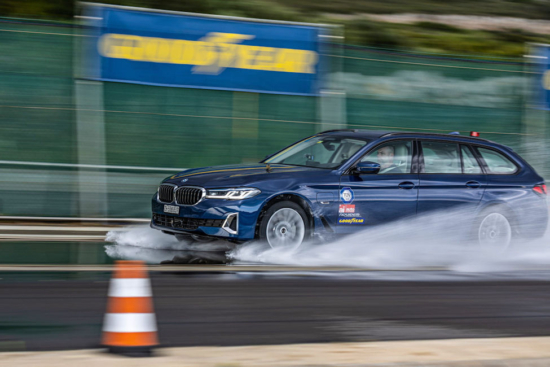Goodyear wins – and loses – tyre test
 Auto-illustrierte pitted Goodyear & Goodyear against Goodyear (Photo: TÜV SÜD)
Auto-illustrierte pitted Goodyear & Goodyear against Goodyear (Photo: TÜV SÜD)
Today isn’t 1 April and no legs were pulled during the writing of the above headline. Swiss motoring magazine auto-illustrierte has published a tyre test – and every single protagonist is a Goodyear tyre. Who stood where on the podium is nonetheless interesting.
Supported by TÜV SÜD, auto-Illustrierte looked at Goodyear tyre models for three different market segments – the EfficientGrip Performance 2 touring tyre in 225/55 R17, the UHP Eagle F1 Asymmetric 6 in 245/45 R18 and the UUHP Eagle F1 SuperSport in 245/40 R19.
Answering the obvious question of why compare three tyres from the same brand instead of the established test format that pits multiple tyre brands against each other, Jörg Petersen, in charge of testing & technology at auto-illustrierte, replies that “the range of tyres (on offer) these days is so large that drivers don’t really know what to buy.” Vincenzo Lucà, mobility press officer at TÜV SÜD, adds that the auto-illustrierte test’s focus is not upon picking a winner, “but rather on finding out and presenting advantages and disadvantages as well as special characteristics, if applicable.”
The Swiss publication examined whether the three models’ properties lived up to their respective designations – in other words, if the EfficientGrip 2 is more economical or whether the Eagle F1 SuperSport is blessed with sportier genes.
Auto-illustrierte and TÜV SÜD tested in seven disciplines: wet braking (from 80 km/h), wet handling (water depth 1mm), longitudinal aquaplaning (water depth 8mm), wet circular track (radius 42 metres), dry braking (from 100 km/h), dry handling (track length of just under 3.1 kilometres) and rolling resistance (test bench). All tyres were fitted to a BMW 530e xDrive Touring, with the Eagle F1 Asymmetric 6 serving as the reference or 100 per cent benchmark.
Buyers need to consider tyre characteristics
“The test showed that premium manufacturers are developing in different directions to cover the needs of drivers as broadly as possible,” says Michael Stamm from TÜV SÜD, who was on site at the Goodyear Test Track in Mireval, France in a support capacity. This means, he adds, that tyre buyers need to consider what characteristics they are looking for in a tyre.
“Because with a particularly economical tyre, it will be more difficult to drive sportily, and with a tyre that comes across as sporty, car owners will certainly make concessions in terms of comfort and durability,” comments TÜV SÜD. However, it must be pointed out that characteristics such as comfort and durability/running performance were not tested at all in this comparison, and as such, statements about economy are limited only to rolling resistance and in turn fuel efficiency.
Results
EfficientGrip Performance 2 was the clear winner of the rolling resistance test, with a coefficient of 7.03 kg/t compared to the reference tyre’s 8.39 kg/t and Eagle F1 SuperSport’s 9.99 kg/t.
Only the wet braking test reveals a larger performance gulf between the Goodyear models. The Eagle F1 Asymmetric 6 delivered wet braking performance that was approximately ten per cent better than both the EfficientGrip Performance 2 and Eagle F1 SuperSport.
On the wet circular track, the EfficientGrip Performance 2 achieved a cornering speed of 64.6 km/h, lagging behind the Eagle F1 Asymmetric 6’s 67.1 km/h.
The Eagle F1 Asymmetric 6 also came out on top in the dry braking test, coming to a stop after 31.5 metres. The Eagle F1 SuperSport needed 33.1 metres to stop and the EfficientGrip Performance 2 required 35.2 metres.
‘Middle’ tyre the best compromise
“In terms of economy and durability, the 17-inch tyre (EfficientGrip Performance 2) is definitely ahead,” concludes Jörg Petersen. “This also applies to rolling resistance, which is significantly higher on the 19-inch SuperSport. No wonder, given that it is designed as a UUHP tyre for 20 per cent circuit and 80 per cent road. The best compromise is the Asymmetric 6, which scores both in terms of sportiness and especially in braking.
“If you are looking for a new tyre that is particularly economical, you will have to accept a slight drop in performance. On the other hand, those who want to be particularly sporty on the road should keep an eye on safety parameters such as wet grip,” recommends Michael Stamm, who adds that everyone must ultimately decide the best economy/performance ratio and compromise for themselves.
“All tyres in the test performed at a very high level, the differences in some criteria were rather small, but in others they could be measured more clearly,” he adds. Stamm emphasises that “all three tyres offer good safety levels and recommends that instead of being swayed by product names, consumers should take a look at the information on the tyre label.






Comments